群论group讲义 theory_3
- 格式:ppt
- 大小:1.23 MB
- 文档页数:30
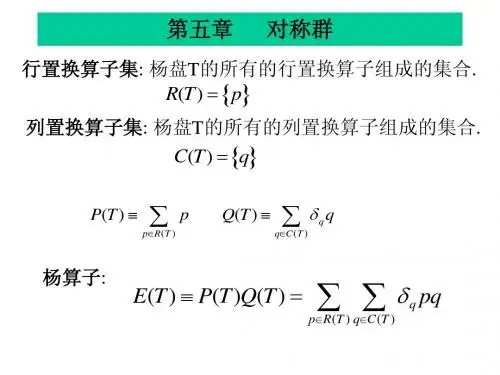
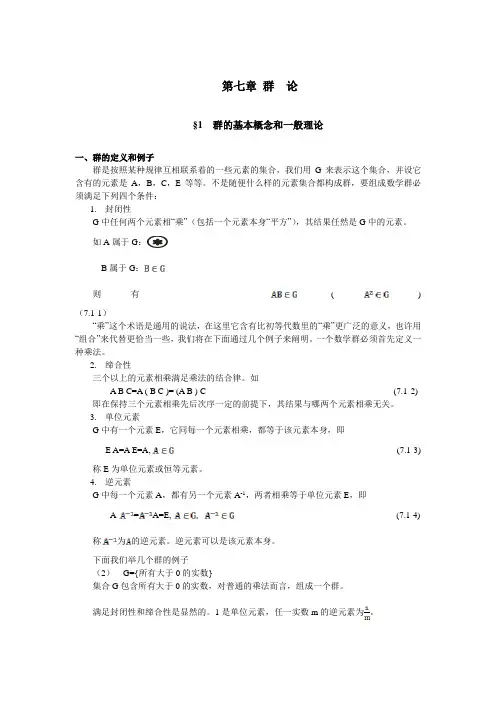
第七章群论§1 群的基本概念和一般理论一、群的定义和例子群是按照某种规律互相联系着的一些元素的集合,我们用G来表示这个集合,并设它含有的元素是A,B,C,E等等。
不是随便什么样的元素集合都构成群,要组成数学群必须满足下列四个条件:1.封闭性G中任何两个元素相“乘”(包括一个元素本身“平方”),其结果任然是G中的元素。
如A属于G:B属于G:则有()(7.1-1)“乘”这个术语是通用的说法,在这里它含有比初等代数里的“乘”更广泛的意义,也许用“组合”来代替更恰当一些,我们将在下面通过几个例子来阐明。
一个数学群必须首先定义一种乘法。
2.缔合性三个以上的元素相乘满足乘法的结合律。
如A B C=A ( B C )= (A B ) C (7.1-2)即在保持三个元素相乘先后次序一定的前提下,其结果与哪两个元素相乘无关。
3.单位元素G中有一个元素E,它同每一个元素相乘,都等于该元素本身,即E A=A E=A,(7.1-3)称E为单位元素或恒等元素。
4.逆元素G中每一个元素A,都有另一个元素A-1,两者相乘等于单位元素E,即A=A=E,(7.1-4) 称为的逆元素。
逆元素可以是该元素本身。
下面我们举几个群的例子(2)G={所有大于0的实数}集合G包含所有大于0的实数,对普通的乘法而言,组成一个群。
满足封闭性和缔合性是显然的。
1是单位元素,任一实数m的逆元素为。
(3) G={0,±1, ±2, ±3……±n…}集合G包含0和所有正负整数,对于加法而言,组成一个群,成为整数加群。
此例中“乘”的意思是加。
1+2=3 封闭性满足1+2+3=1+(2+3)=(1+2)+3=6 缔合性满足0+3=3+0=3 0是单位元素n+(-n)=0 n有逆元素-n 213(4)G={E、I} ( C i )这个群(称为C i)里面的二个元素是“对称操作”,E是不动,I为对原点的倒反。
这种群(组成元素是一些对称操作)称为对称群或点群。
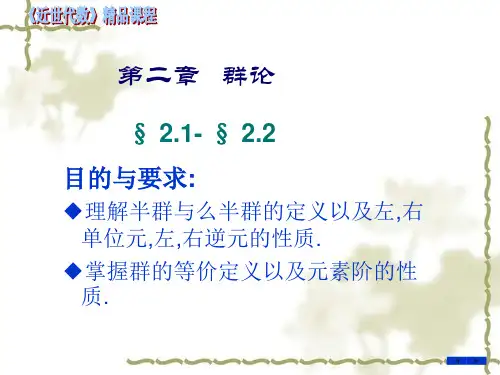

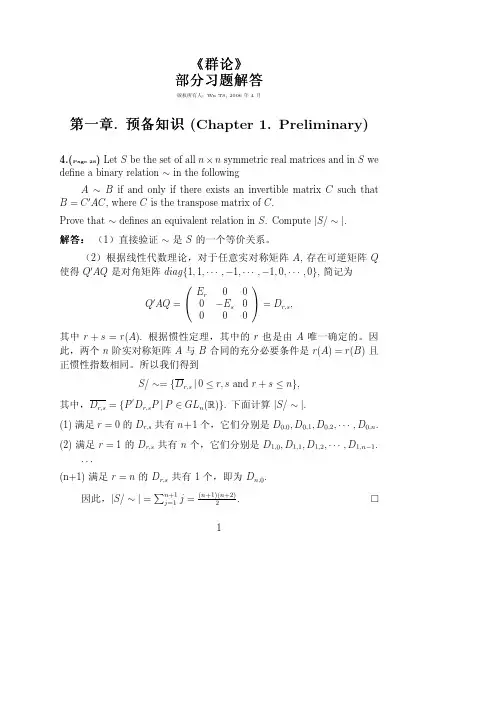
《群论》部分习题解答版权所有人:Wu TS,2006年4月第一章.预备知识(Chapter1.Preliminary) 4.(Page28)Let S be the set of all n×n symmetric real matrices and in S we define a binary relation∼in the followingA∼B if and only if there exists an invertible matrix C such that B=C AC,where C is the transpose matrix of C.Prove that∼defines an equivalent relation in pute|S/∼|.解答:(1)直接验证∼是S的一个等价关系。
(2)根据线性代数理论,对于任意实对称矩阵A,存在可逆矩阵Q 使得Q AQ是对角矩阵diag{1,1,···,−1,···,−1,0,···,0},简记为Q AQ=E r000−E s0000=Dr,s,其中r+s=r(A).根据惯性定理,其中的r也是由A唯一确定的。
因此,两个n阶实对称矩阵A与B合同的充分必要条件是r(A)=r(B)且正惯性指数相同。
所以我们得到S/∼={D r,s|0≤r,s and r+s≤n},其中,D r,s={P D r,s P|P∈GL n(R)}.下面计算|S/∼|.(1)满足r=0的D r,s共有n+1个,它们分别是D0,0,D0,1,D0,2,···,D0,n.(2)满足r=1的D r,s共有n个,它们分别是D1,0,D1,1,D1,2,···,D1,n−1.···(n+1)满足r=n的D r,s共有1个,即为D n,0.因此,|S/∼|=n+1j=1j=(n+1)(n+2)2.1第二章.群论(Chapter2.Group Theory)1.(Page49)Prove that both G1={(a ij)n×n|a ij∈Z,det(A)=1}and G2= {(a ij)n×n|a ij∈Q,det(A)=1}are groups under the matrix multiplication.证明:只证明G1是子群。

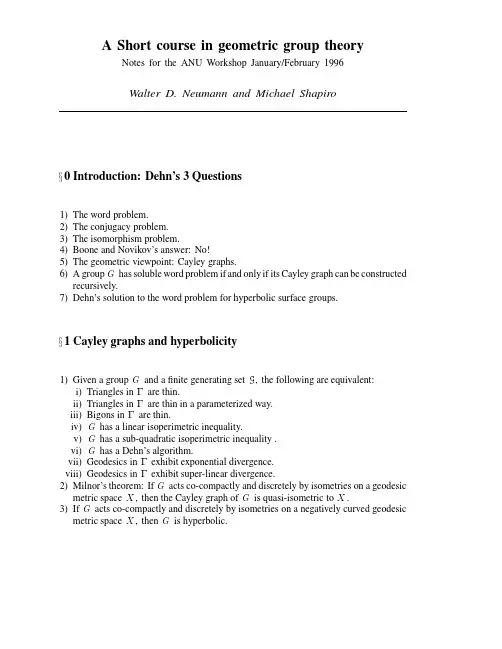
A Short course in geometric group theoryNotes for the ANU Workshop January/February1996Walter D.Neumann and Michael Shapiro2Geometric Group Theory2Elementary properties of hyperbolic groups1)Behaviour of geodesics and quasi-geodesics:progression in geodesic corridors.2)Hyperbolicity is a quasi-isometry invariant.3)Finite presentation,solubility of the word and conjugacy problems.4)Finitely many conjugacy classes of torsion elements.5)The Rips complex and.6)The boundary.3Isoperimetric inequalities1)Area of a word via products of conjugates of relators.2)Area of a word via V an Kampen diagrams.3)Dehn’s functions and isoperimetric functions.4)A group has soluble word problem if and only if it has a recursive Dehn’s function ifand only if it has a sub-recursive Dehn’s function.5)Equivalence relation and ordering for isoperimetric functions.6)Consequently solubility of the word problem is a geometric property.4The JSJ decomposition1)Splittings of hyperbolic groups.5Regular languages,automatic,bi-automatic and asynchronously automatic groups1)Definitions.2)The fellow traveler property.3)The seashell:finite presentation,quadratic isoperimetric inequality and quadratic timeword problem.4)Closure properties.i)Free products.ii)Direct products.iii)Free factors.iv)Finite index subgroups.v)Finite index supergroups.vi)HNN extensions and free products with amalgamation overfinite subgroups. vii)Bi-automatic groups are closed under central quotients and direct factors.5)Famous classes of automatic groups.Geometric Group Theory3i)Hyperbolic groups including:free groups,finite groups,most small cancella-tion groups,fundamental groups of closed negatively curved manifolds and other negatively curved spaces.ii)Small cancellation groups.iii)Fundamental groups of geometric three manifolds except for those containing a nil or solv manifold as a connected sum component.iv)Coxeter groups.v)Mapping class groups.vi)Braid groups and more generally,Artin groups offinite type.vii)Central extensions of hyperbolic groups.viii)Many amalgams of hyperbolic groups along rational subgroups.ix)Many groups that act on affine buildings.6)Regular languages,cone types and the falsification by fellow traveler property.7)Bi-automatic groupsi)Hyperbolic groups are geodesically bi-automatic.ii)Bi-automatic groups have soluble conjugacy problem.8)Asynchronous automaticity6Equivalence classes of automatic structures1)The asynchronous fellow traveller property,rationality and bi-automaticity.7Subgroups of automatic groups1)Let be a(synchronous or asynchronous)automatic structure for,and suppose.Then the following are equivalent:i)is-rational.ii)is-quasi-convex.iii)In the case where is hyperbolic and is synchronous,these are equivalent to: is quasi-geodesic in.2)A rational subgroup of an automatic(bi-automatic,asynchronously automatic,hyper-bolic)group is automatic(bi-automatic,asynchronously automatic,hyperbolic).3)Centers and centralizers of bi-automatic groups are rational,hence bi-automatic.i)Consequently a hyperbolic group does not contain a subgroup.8Almost convexity1)Definition.2)Building the Cayley graph.3)Almost convexity is not a group property.4Geometric Group Theory9Growth functions and growth rates1)Finite cone types implies rational growth function.2)Gromov’s theorem:polynomial growth implies virtually nilpotent.Geometric Group Theory5 0.IntroductionGeometric group theory is the study of groups from a geometric viewpoint.Much of the essence of modern geometric group theory can be motivated by a revisitation of Dehn’s three decision-theoretic questions,which we discuss below,in light of a modern viewpoint.This viewpoint is that groups may be profitably studied as geometric objects in their own right.This connection between algorithmic questions and geometry is atfirst surprising,and is part of what makes the subject attractive.As Milnor’s theorem(see below)teaches us,the geometry exists both in the group itself and in the spaces it acts on.This is another powerful motivation for the subject,and was historically one of the turning points.0.1–4Dehn’s problems.Early in this century Dehn proposed three seminal questions[D].Suppose we have a group given in some way,and a set of generators for the group.The word problem asks if there is a procedure to determine whether two words and in these generators represent the same element of.Since we may look at,it is equivalent to ask for a procedure to decide if a word represents the identity.Notice that if and are twofinite generating sets for then the word problem is soluble with respect to if and only if it is soluble with respect to.For suppose we are given a word in the letters of.Each letter has the same value in as some word in the letters of.Thus it requires only afinite look-up table to translate a word in the letters of into one in.However,there is less here than meets the eye.We have said nothing about how to find thefinite look-up table.Thus while we have demonstrated the existence of an algorithm for the word problem in from the existence of one in,we may have no way offinding that solution.The conjugacy problem asks if there is a procedure to determine whether the elements and of represented by two words and are conjugate in,that is,does there exist with.Note that if such a procedure exists,then,taking ,we solve the word problem also.The isomorphism problem asks for a procedure to determine whether two groups are isomorphic.The groups are usually assumed to be given by presentations(a“presentation" is a collection of generators for the group plus some sufficient collection of relations among these generators).Dehn’s three questions are remarkable in that they precede by many years the for-malization of“procedure"as“algorithm"by Church,Turing,et al.and by two more decades the resolution of the word problem by Boone and Novikov in the1950’s.They show that there is afinitely presented group with recursively unsolvable word problem. The unsolvability of the conjugacy problem is immediate,and that of the isomorphism problem also follows.For more details see ler’s notes for this Workshop.6Geometric Group Theory0.5Cayley graphsThere is a standard method for turning a group and a set of generators into a geometric object.Given the group and generating set we produce the directed labeled graph .The vertices of are the elements of and we draw a directed edge from to with label for each and.We will refer to this edge as.This graph is called the Cayley graph.It comes equipped with a natural left action of .acts on vertices by left-multiplication and carries the edge to .By forgetting directions on edges and making each edge have length,we can turn into a metric space.This induces the word metric on the vertex set:inThis metric depends of course on the chosen set of generators.But we will see below that up to“quasi-isometry”it does not depend on this choice(if the generating set isfinite) and that many geometric properties depend only on.We use to denote the set of all words on letters of,including the empty word and for we usefor.The path is a geodesic if.Evidently,a word represents the identity if and only if it is a closed loop.It follows that Theorem.has soluble word problem if and only if there is an algorithm capable of constructing anyfinite portion of.For suppose we are in possession of such an algorithm,and we are given the word. The path lies entirely inside the ball of radius around the identity.We use our algorithm to construct this ball and then follow to see if it returns to the identity.On the other hand,suppose we are given an algorithm to solve the word problem in .To construct the ball of radius around the identity,we enumerate the words of length less than or equal to in.We then use our algorithm for the word problem to determine which of these are equal in.Equality in is an equivalence relation on .Pick a representative(say a shortest representative)in each equivalence class.Now for each and each pair of representatives,use word problem algorithm to determine if is an edge.Geometric Group Theory7 0.7Dehn’s solution to the word problem for hyperbolic surfacegroups.The previous algorithms are wildly impractical in most situations.There is a beautiful and highly efficient solution to the word problem for hyperbolic surface groups.Let us start by describing an inefficient solution to the word problem in.If we take in the standard presentation,the Cayley graph embeds in the Euclidean plane as the edges of the tessellation by squares.We can see this embedding as an expression of the fact that acts by isometries on the Euclidean plane.The quotient of the Euclidean plane by this action is the torus.Now we are entitled to see the tessellation of the plane by squares as being the decomposition of the plane into copies of a fundamental domain for this action.However,there is a little piece of sleight-of-hand going on here.To see this,let’s start with the torus.If we cut the torus open along two curves,it becomes a disk,in fact,if we choose the two curves correctly,it is a square.That is,the torus is the square identified along its edges.If we look for the generators of the fundamental group,they are dual to the curves we have cut along.That is,if we take a base point in the middle of the square,is the curve which starts at the base point,heads towards the right edge of the square,reappears at the left edge and continues back to the base point.Likewise,is the vertical path which rises to the top edge and reappears at the bottom.Thus the fundamental group is generated by the act of crossing either of the cut curves.Thus,after choosing a base point,the natural relation between the tessellation of the plane and the embedding of the Cayley graph into the plane is that they are dual.That is,there is a vertex of the Cayley graph in the center of each copy of the fundamental domain,and there is an edge of the Cayley graph crossing each edge of the tessellation.The reason it was not immediately obvious that the tessellation and the Cayley graph are two different things is that the tessellation of the plane by squares is self-dual.That is,if we start with the tessellation of the planes by squares and replace each vertex by a2-cell and each2-cell by a vertex(thus getting new edges crossing our old edges)the result is another tessellation of the plane by squares.Contrast this with the tessellation of the plane by equilateral triangles which is dual to the tessellation of the plane by regular hexagons.Now as we have seen,finding the Cayley graph for solves the word problem for ,but it does not lead to a particularly efficient solution.This situation changes if we turn to the fundamental group of a hyperbolic surface, i.e.,a surface of genus2or more.If we wish to cut open a surface of genus2,we will need4curves,and when we have cut it open,we will have an octagon as our fundamental domain.Likewise,looking at the vertex where our cut curves meet shows that we will want to tessellate something with8octagons around each vertex.This suggests that we would like regular octagons with interior angles of.We can have this if we choose to work in the hyperbolic plane.In fact,the hyperbolic plane can be tessellated by regular octagons with interior angles of.Once again,the Cayley graph is dual to the tessellation,and this tessellation is also self-dual,so the Cayley graph embeds as the edges of this tessellation.In fact,reading8Geometric Group Theorythe labels on an octagon tells us that our fundamental group has the presentation Given a sub-complex of this tessellation,we define to be together with any fundamental domains which meet.Now suppose we start with a vertex of this tessellation(identified with the identity)and consider for successive values of.We can then observe that each fundamental domain that meets the boundary of meets it in at least of its edges.Suppose now that we are given a word which represents the identity.We consider as a path based at.There is a smallest so that lies entirely in.If then is the empty word.If,then there is some portion of which lies in,but not in.Suppose is a maximal such portion.Then one of2things happens.Either:1)returns to along the same vertex by which it left it,in which caseis not reduced or2)travels along the edges of some2-cell which meet the boundary of.Call this portion.In thefirst case,can be reduced in length by deleting a subword of the form, producing a new word with the same value in.In the second case,we take to be the path so that forms the boundary of. We now have evaluating to the identity,so and have the same value in. Further,.If we work with a surface of genus greater than,the numbers change,but the argument stays the same.Thus we have proven:Theorem(Dehn).Let be the fundamental group of a closed hyperbolic surface.Then there is afinite set of words with each evaluating to the identity, so that if is a word representing the identity,then there is some so that and.This gives a very efficient solution to the word problem.Given a word we look for an opportunity to shorten it and do so if we can.After at most such moves we either arrive at the empty word or we have no further opportunities to shorten our word. If thefirst happens,we have shown that represents the identity.If the second happens, we have shown that it does not.1.1HyperbolicityLet be afinitely generated group withfinite generating set and let be the corresponding Cayley graph.i).We say that has thin triangles if there exists a such that if,,and are sides of a geodesic triangle in then lies in a-neighbourhood of.ii).We can give a parameterized version of the above condition.Wefirst note the following.If is a geodesic triangle,then the sides of decompose(as paths parameterized by arclength)as,,so thatGeometric Group Theory9 ,,and.(This is the triangle inequality.Exercise!)The parameterized version of the previous condition is that there exists such that for any such triangle each of the pairs,;,;,-fellow travel,that is for and so on.The reader may wish to check that suffices.iii).We say that has thin bigons if there is a such that for every pair of geodesics and with the same endpoints,for.(We call such a pair a geodesic bigon.)Warning:we are here treating as a bonafide geodesic metric space.Accordingly,we must allow the endpoints of geodesics to occur in the interior of edges.iv).We shall see that a group obeying any of these conditions isfinitely presented.That is to say,there is a presentationwhere consists of afinite set of words on the set of generators andis isomorphic to the quotient of the free group on by the normal closure of.Another way of saying this is that a word in the letters of represents the identity in if and only if it is freely equal to a product of conjugates of elements of.Thus a word in represents the identity if is equal(in the free group on to an expression of the formWe say that has a linear isoperimetric inequality if there is a constant so that for any trivial word we can satisfy this equation with.v).We say that has a sub-quadratic isoperimetric inequality if there is a sub-quadratic function so that for any word presenting the identity,can be freely expressed as the product of at most conjugates of defining relators.vi).We say that has a Dehn’s algorithm if there is afinite set of words with each evaluating to the identity,so that if is a word representing the identity,then there is some so that and.10Geometric Group TheoryWe have seen that this gives an algorithm.Given a word,we can replace it with the shorter word which evaluates to the same group element.If does in fact represent the identity,after at most such moves,we are left with the empty word. If does not represent the identity,after at most such moves,we are left with a word which we cannot shorten.vii).We will say that geodesics diverge exponentially in if there is a constant and an exponential function()with the following property:Suppose that and are geodesic rays based at a common point.Suppose that there is a value so that .Suppose now that is a path connecting toand that lies outside the ball of radius around.Then. viii).We will say that geodesics diverge uniformly in if there is a constant and a function,,with the following property:Suppose that and are geodesic rays based at a common point.Suppose that there is a value so that .Suppose now that is a path connecting toand that lies outside the ball of radius around.Then. Theorem.All the above conditions are equivalent and independent of generating set.A group satisfying them is called word hyperbolic.Conditions i),ii),and vii)are equivalent to each other for any geodesic metric space and are characterizations of a type of hyperbolicity in such spaces called Gromov-Rips hyperbolicity.In a class of spaces including complete simply connected riemannian manifolds they are also equivalent to linear isoperimetric inequality.In these spaces linear isoperimetric inequality means the existence of a constant such that a closed loop can always be spanned by a disk of area at most.The thin bigons condition is equivalent to Gromov-Rips hyperbolicity in any graph with edges of unit length(see[Pa2]),but certainly not in arbitrary geodesic metric spaces (think of euclidean space!).Conditions i),ii),iv),vi),and vii)can be found in general expositions such as[ABC], [B],[C3],[CDP],[GH].Conditions v)and viii)can be found in[Pa1].1.2Cayley graphs and group actionsWe say that a metric space is a geodesic metric space if distances in are realized by geodesics in That is,given,there is a path connecting and so that and is minimal among all paths connecting and.A map is a quasi-isometric map if for all,Suppose now that is a geodesic metric space.Suppose that is afinitely generated group which acts by isometries on.Suppose further that this action is discrete and co-compact.“Discrete”means that if is a sequence of distinct group elements then for the sequence does not converge(this isslightly weaker than“proper discontinuity”).“Co-compact"means that the orbit space is compact.Let usfix a generating set for and pick a basepoint,.The map which takes to takes to,is-equivariant,and isfinite-to-one since the action of is discrete.For each,we choose a path from to.We now have a mapdefined by taking each vertex of to,and each edge of to. (Strictly speaking,we must parameterize both the edge and the path by the unit interval and take to.)Theorem(Milnor)[M].The map is a quasi-isometry.This is not a particularly difficult theorem—indeed,the reader may wish to try to prove it as an exercise.However,as mentioned in the Introduction,it was one of the turning points in the development of modern geometric group theory.1.3Groups acting on hyperbolic spaces.In view of Milnor’s Theorem,we will want to see that any space which is quasi-isometric to a hyperbolic space is itself hyperbolic.This will show that co-compact discrete action of a group on a hyperbolic space“transfers"the hyperbolicity of to.It will also show that hyperbolicity is independent of generating set.2.1Quasi-geodesics in a hyperbolic spaceA geodesic is an isometric map of the interval.(Y ou may take this a definition of.)A-quasi-geodesic is a-quasi-isometry of the interval .Here are several characterizations of the relationship between geodesics and quasi-geodesics in a hyperbolic space.Given a path it is often convenient to extend it to a map defined on by setting for.We use this convention in the following theorem. Theorem.There are,,and so that ifis a-quasi-geodesic and is a geodesic in and is-hyperbolic,and and have the same endpoints,then each of the following hold:i).Each of and is contained in an-neighbourhood of the other.ii).and asynchronously-fellow travel.That is,there is a monotone surjective reparameterization of so that for all we have. iii).progresses at some minimum rate along.That is,the reparameterization of ii) can be chosen so that implies.This last is sometimes referred to as “progression in geodesic corridors."2.2Hyperbolicity is a quasi-isometry invariantWe now prove that hyperbolicity is a quasi-isometry invariant using the previous theorem and a picture.Theorem.Suppose thatand are quasi-isometric geodesic metric spaces.If ishyperbolic,so is.2.3Word and conjugacy problem for hyperbolic groupsIt follows immediately from the existence of a Dehn’s algorithm that a hyperbolic group has a highly efficient solution to its word problem.Most early solutions to the conjugacy problem used the boundary of a hyperbolic group,which will be described later.We will give a proof in 5.7due to Gersten and Short which works in the more general setting of biautomatic groups,and which does not use the boundary.2.4Torsion in hyperbolic groupsThere is a charming proof that hyperbolic groups have finitely many conjugacy classes of torsion elements based on the Dehn’s algorithm.See for example,[ABC ].2.5The Rips ComplexA fundamentally important property of a hyperbolic group is:Theorem (Rips).Let be a hyperbolic group.Then acts properly discontinuously on a finite dimensional contractible complex with compact quotient.Such a complex is easy to describe.We start with a Cayley graph for and take the geometric realization of the following abstract simplicial complexfor an appropriate bound.V ertex set of is and the simplices consist of subsets of of diameter at most in the word metric.It turns out thatalways suffices.A very efficient proof of Rips’theorem is given in[ABC].This theorem has important homological implications for.For example,if is virtually torsion free(i.e.,has a torsion free subgroup offinite index)then it hasfinite virtual cohomological dimension and in any case its rational homology and cohomology isfinite dimensional.It is an important open problem whether a hyperbolic group is always virtually torsion free.Another interesting consequence is that non-vanishing homology implies a lower bound for the hyperbolicity constant for among allfinite generating sets for .2.6The boundary of a hyperbolic groupFor a hyperbolic group(in fact more generally for any Gromov/Rips hyperbolic metric space)there is a natural compactification of by adding a“boundary at infinity.”Roughly speaking the boundary consists of the set of all ways to travel off to infinity. One way of making this precise is to define a geodesic ray in a Cayley graph for as an isometry of into and to say two rays are equivalent if they fellow travel. The boundary(which in fact is a quasi-isometry invariant and thus does not depend on the choice of generating set)is the set of equivalence classes of geodesic rays.The topology on can be defined in a multitude of ways.Basicly two points are close if their rays fellow travel for a long time.One way to formalize this is to take the compact open topology on the set of rays and take the quotient topology on.There are also many ways of describing how to attach this boundary to or its Cayley graph.One obtains a compact Hausdorff space into which both and embed. We leave as an exercise how to attach the boundary:the construction is highly stable in the sense that any reasonable answer you give will be correct(see[NS1]).3.1Area of a word that represents the identityAs we have seen,a group with presentationis isomorphic to,where is the free group on and is the normal closure of in.It follows that a word represents the identity in if and only if it is freely equal(that is,equal in)to an expression of the formwhere each.Thus,solving the word problem in means determining the existence or non-existence of such an expression for each.A naive approach would be to start enumerating all such expressions in hopes of finding one freely equal to our given.If represents the identity,we must eventuallyfind the expression that proves this.The problem with this approach is knowing when to give up if does not represent the identity.Let us formalize this quandary.Suppose we take a word representing the identity in.We define the area,to be the minimum in any such expression for.3.2Van Kampen diagramsThe choice of the word area is motivated the notion of a V an Kampen diagram for. Such a diagram is a labeled,simply connected sub-complex of the plane.Each edge of is oriented and labeled by an element of.Reading the labels on the boundary of each2-cell of gives an element of.is a V an Kampen diagram for if.reading the labels around the boundary of givesTheorem.Each Van Kampen diagram with2-cells for gives a way of expressing as a product.Each product for gives a Van Kampen diagram for with at most2-cells.In particular,has a Van Kampen diagram if and only if represents the identity.Thus,we could have defined to be the minimum number of2-cells in a V anKampen diagram for.3.3Dehn’s function of a presentationWe define the Dehn’s function of the presentation to beThis maximum is taken over words presenting the identity.We say is an isoperimetricfunction for if.(As we shall see below,“isoperimetric function”is often used in a sense between these two.)3.4Isoperimetric functions and the word problemEither of these functions answers the question,“When should we give up?"Theorem.has a soluble word problem if and only if it has a recursive Dehn’s function if and only if it has a sub-recursive Dehn’s function(and the same for isoperimetric functions).A function is recursive if it can be computed by some computer program.It is sub-recursive if there is a recursive function so that for all. Proof.If a given word represents the identity,we can eventually exhibit a V an Kampen diagram for it by sheer perseverance.The Dehn’s function(if we can compute it or an upper bound for it)tells us the maximum number of2-cells in any V an Kampen diagram we must consider.Now,the number of possible V an Kampen diagrams with a given number of two cells is unbounded,because such diagrams may have long1-dimensional portions.However,the length of the boundary of such a diagram is at least twice the total length of the1-dimensional portions.Thus any possible diagram for has at most 2-cells and at most3.6The word problem is geometricTheorem.The property of having soluble word problem is a quasi-isometry invariant of finitely presented groups.This follows because the property of being sub-recursive is an equivalence class invariant of functions.Since groups with unsolvable word problem exist,isoperimetric functions can be of enormously rapid growth.In fact,by their definition,non-sub-recursive functions can be thought to have“inconceivably rapid growth.”It is not hard tofind groups with solvable word problem with very fast growing Dehn functions—for example,Gersten has pointed out[G]that for any the function (levels of exponent)is a lower bound for the isoperimetric function for the group(the notation is a shorthand for).Clearly,the algorithm proposed above for the word problem—enumerating all V an Kampen diagrams up to the size given by the Dehn function—is absurd when one has a Dehn function that grows this fast(or even exponentially fast).For specific groups much faster algorithms can often be found.4JSJ decomposition.The name JSJ refers to Johannson,and Jaco and Shalen,who developed a theory,building on earlier ideas of Waldhausen,for cutting irreducible three-dimensional manifolds into pieces along tori and ter Thurston explained these decompositions from a geometric point of view in his famous“Geometrization Conjecture"for3-manifolds.One can describe JSJ decomposition in terms of amalgamated product and HNN decomposition of the relevant fundamental group,and in fact a purely group theoretic version of the theory has been worked out by Kropholler and Roller.Around1992Zlil Sela pointed out that analogous decompositions appear to exist for groups in a much broader range of situations.First Sela did this for torsion free hyperbolic groups and then Sela and Rips extended it to general torsion freefinitely presented groups.This is currently a very active area of research,and we can only touch on some of its coarsest elements here.Since some of the major players are here at this workshop(Swarup,Bowditch),we can hope to learn more in seminars.In fact we are indebted to them for the information in this section,although any errors in it are our responsibility.The theory also has origins in work of Stallings on“ends of groups."The set of ends of a locally compact space is the limit over larger and larger compact subsets of of the set of components of.The set of ends of afinitely generated group is the set of ends of any connected space on which acts freely with compact quotient —for example one may take a Cayley graph of the group.The definition turns out to be independent of choices.For example,has two ends,has one end for,and a free group on two or more generators has infinitely many ends,since its Cayley graph。
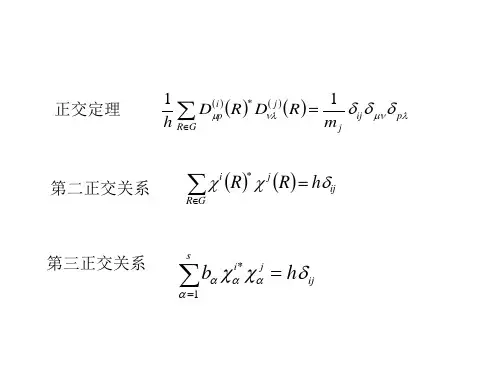
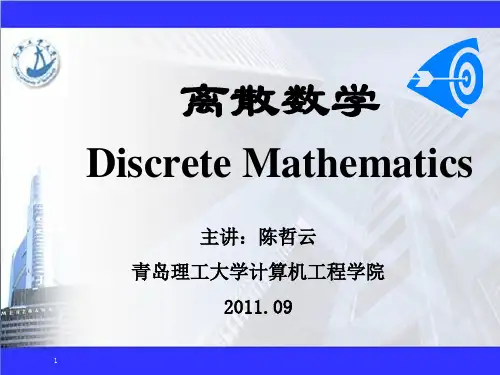

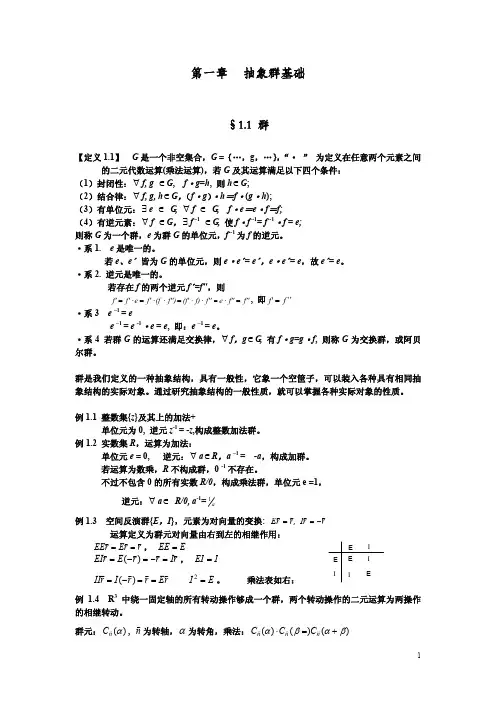
石家庄铁道学院毕业论文群的阶与其元素的阶的关系摘要近世代数虽是一门较新的,较抽象的学科,但如今它已渗透到科学的各个领域,解决了许多著名的数学难题:像尺规作图不能问题,用根式解代数方程问题,编码问题等等.而群是近世代数里面最重要的内容之一,也是学好近世代数的关键.本论文旨在从各个角度和方面来探讨群的阶与其元的阶之间的关系.具体地来说,本文先引入了群的概念,介绍了群及有关群的定义,然后着重讨论了有限群、无限群中关于元的阶的情况.并举了一些典型实例进行分析,之后又重点介绍了有限群中关于群的阶与其元的阶之间的关系的定理——拉格朗日定理,得出了一些比较好的结论.在群论的众多分支中,有限群论无论从理论本身还是从实际应用来说,都占据着更为突出的地位.同时,它也是近年来研究最多、最活跃的一个数学分支.因此,在本文最后,我们介绍了著名的有限交换群的结构定理,并给出了实例分析.关键词:群论有限群元的阶石家庄铁道学院毕业论文AbstractThe Modern Algebra is a relatively new and abstract subject, but now it has penetrated into all fields of science and solved a number of well-known mathematical problems, such as, the impossibility for Ruler Mapping problem, the solutions for algebraic equations with radical expressions, coding problems and so on. The group is one of the most important portions in the Modern Algebra, and also the key of learning it well.This paper aims at discussing the relations between the order of a group and the orders of its elements from all the angles and aspects. Specifically, this thesis firstly introduces the concept of a group and some relatives with it; secondly focuses on the orders of the elements in the finite group and the infinite group respectively, some typical examples are listed for analyses; thirdly stresses on the theorem - Lagrange's theorem on the relations between the order of a group and the orders of its elements in the finite group, accordingly obtaining some relatively good conclusion.In the many branches of group theory, the finite group theory, whether from the theory itself or from the practical applications, occupies a more prominent position. At the same time, it is also one of the largest researches and the most active branches of mathematics in the recent years. Therefore, in this paper finally, we introduce the famous theorem of the structures on the finite exchanging groups, and give several examples for analyses.Key words:group theory finite groups the orders of elements石家庄铁道学院毕业论文目录1绪论 (1)1.1 群论的概括 (1)1.2 群论的来源 (1)1.3 群论的思想 (2)2 预备知识 (2)2.1 群和子群 (2)2.1.1 群的定义 (2)2.1.2 群的阶的定义 (3)2.1.3 元的阶的定义 (4)2.1.4 子群、子群的陪集 (5)2.1.5 同构的定义 (6)2.2 不变子群与商群 (6)2.2.1 不变子群与商群 (6)2.2.2 Cayley(凯莱)定理 (7)2.2.3 内直和和外直积的定义 (8)3 群中元的阶的各种情况及其实例分析 (8)3.1 有限群中关于元的阶 (9)3.1.1 有限群中元的阶的有限性 (9)3.1.2 有限群中关于元的阶及其个数的关系 (9)3.2 无限群中关于元的阶 (10)3.2.1 无限群G中,除去单位元外,每个元素的阶均无限 (10)3.2.2 无限群G中,每个元素的阶都有限 (10)3.2.3 G为无限群,G中除单位元外,既有无限阶的元,又有有限阶的元 (11)4 群的阶与其元的阶之间的关系 (11)4.1 拉格朗日(Lagrange)定理 (11)4.1.1 拉格朗日定理 (11)4.1.2 相关结论 (12)4.2 有限交换群的结构定理 (13)4.2.1 有限交换群的结构定理 (13)石家庄铁道学院毕业论文4.2.2 相关例子 (14)参考文献 (15)致谢 ······································································错误!未定义书签。